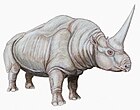Proboscidipparion
Appearance
| Proboscidipparion Temporal range:
| |
|---|---|

| |
| Skulls of Proboscidipparion pater | |
| Scientific classification | |
| Domain: | Eukaryota |
| Kingdom: | Animalia |
| Phylum: | Chordata |
| Class: | Mammalia |
| Order: | Perissodactyla |
| Family: | Equidae |
| Subfamily: | Equinae |
| Tribe: | †Hipparionini |
| Genus: | †Proboscidipparion Sefve, 1927 |
| Species | |
|
†P. heintzi | |
Proboscidipparion is an extinct genus of hipparionine equine. It is named after its unusual retracted nasal region of the skull, which may have supported a proboscis.[1] Fossils have been found throughout Eurasia, from England to China.[2][3] The oldest specimens are known from Asia, dating to the Early Pliocene, around 5.3-5 million years ago. The genus was one of the last surviving hipparionines, with the youngest specimen dating to the end of the Early Pleistocene, around 1 million years ago.[1]
References
[edit]- ^ a b Bernor, Raymond L.; Kaya, Ferhat; Kaakinen, Anu; Saarinen, Juha; Fortelius, Mikael (October 2021). "Old world hipparion evolution, biogeography, climatology and ecology". Earth-Science Reviews. 221: 103784. Bibcode:2021ESRv..22103784B. doi:10.1016/j.earscirev.2021.103784.
- ^ Sciences, Chinese Academy of. "Skull of Three-Toed Horse Found". ScienceAlert. Archived from the original on 2018-05-13. Retrieved 2018-05-12.
- ^ Wang, Xiaoming (2013-05-14). Fossil Mammals of Asia: Neogene Biostratigraphy and Chronology. Columbia University Press. ISBN 9780231520829.









